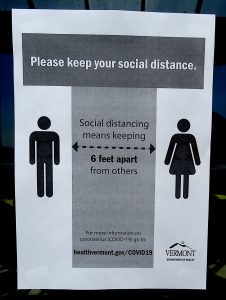By Jade Lutes

Six feet? How does anyone have a medical visit staying six feet away from your doctor?
Keeping such distance is the recommended best practice during the first pandemic in over 100 years is to stay six feet away from anyone. COVID-19 has forced people to look for alternatives when needing to see a doctor or a therapist for medical conditions not directly related to the virus to avoid the potential exposure. The medical community has responded by getting creative.
Local primary care clinics in Kodiak, Alaska, rely on a drive-through testing site handling patients with suspected COVID-19 symptoms. Some clinics have even been sending their patients to locations designated specifically for those with upper respiratory symptoms, or a travel or contact history that has brought them into potential contact with positive cases.
Many services provided by chiropractors, physical therapists, and mental health therapists are all considered essential services. As such, those offices are still allowed to stay open to serve the community. However, they will be using methods that avoid the spread of the virus. “All manual therapy at our office stopped effective March 24,’ said Dr. Laura Homacki, 34, a local chiropractor and retired army medic. “Right now, we are only allowing one patient into the clinic at a time for chiropractic services, and after they leave we clean and disinfect everything. We’re really only allowed to see acute patients right now,’ she added, “ to free up other medical staff, emergency rooms, and doctor’s offices so that they can focus on treating people with the virus.’

One of the increasingly common options to help patients continue to access services is using telemedicine. Prior to the outbreak of COVID-19, it wasn’t a common option to deliver physical therapy. Dr. Hannah Donadio, 29, a local physical therapist, says “With my sessions moving to telehealth only, I’ve had to work quickly to adapt my treatments to distance sessions and learn the technology portion.’ Some of her patients who were initially hesitant to have telehealth sessions gave it a try and have been pleased with both the process and the results.
“Before needing to quarantine, I would never have considered telehealth for my physical therapy,’ said McKinzie Grasmick, 39, “But it has been super convenient to log off my work computer and dial into my session with my phone.’ The profession as a whole was already starting to move toward delivering online access to physical therapy sessions,’ Donadio said. “This virus situation has really just forced us to get started right away.’
Mental health professionals are also embracing telehealth visits. In Alaska, mental health therapy was already being used to deliver therapy services to rural communities. With the spread of COVID-19, many practitioners’ therapy sessions have moved entirely to telehealth visits. Jessica Kell, 39, a local licensed professional counselor said the transition has gone smoother than expected. “We’re finding our patients are being really, really flexible. It seems like when there is something serious going on in the world people get less neurotic and get really serious about accessing the help they need’.

The changes that these medical offices are experiencing are proving educational for professionals as well. “The population that we thought would be the most challenging has been the biggest surprise,’ Kell said. “Our substance misuse therapy clients have been more engaged in their group treatment video conferences than they ever were in face to face group therapy sessions.’ The change in response from participants in these group sessions show that connection to others is important when self-isolating, it reminds us that we’re not alone.
Telemedicine has been a real benefit to small communities like Kodiak, Alaska, allowing residents access to essential services without increased risk of exposure to COVID-19. To-date, the city of Kodiak, Alaska, has had only 1 positive case. “Honestly, I am surprised that overall telehealth has been a mainly positive experience for both providers and patients,’ said Dr. Homacki, the chiropractor, “It’s been easier to navigate than I had originally thought.’

Sundog Times
Self-described “former flat-lander, part-time nomad” Jade Lutes is majoring in social work and minoring in digital journalism at UAF. The Alaska denizen describes herself as a dog-mom, music lover, knit & fiber arts enthusiast, and foodie.
- Quarantine deepens, changing healthcare delivery - April 30, 2020
